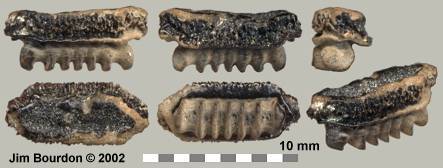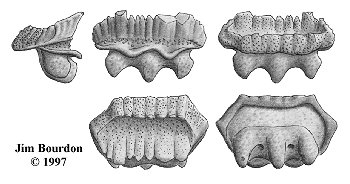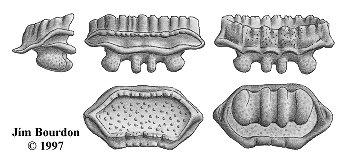| |
Superficially and without magnification, the teeth of this genus are reminiscent of those of the
rhinopterids (cow-nose rays). Occlusally, the teeth are hexagonal in shape and are arranged
in a pavement-like fashion. Medial teeth are laterally elongated compared with those from
lateral files. The lack of wear on fossil specimens suggests that the genus feed on small soft prey.
Viewed under magnification, the roots are mobulid-like and the occlusal face of the crown bears
a deep ornamented depression. Laterally, the labial crown face is lower than the lingual and
may be less upright. The labial margin of the crown extends significantly beyond the labial
face of the root. Cappetta (1987) indicated that teeth from this genus are up to 2.0 cm in width.
Burnhamia daviesi (WOODWARD, 1889) has been reported from
the Upper Paleocene - Middle Eocene of Asia, Europe, North Africa & North America and
B. fetahi CAPPETTA, 1985 from the Lower Eocene of Morocco
and North America. Noubhani & Cappetta (1997) discuss a few Burnhamia tooth designs that
fill the gap between B. daviesi and B. fetahi during the Ypresian of Morocco. Case (1994)
included B. daviesi & B. fetahi in the Early Eocene fauna of Mississippi.
 |
Fig. 1 - Burnhamia sp
Piscataway Mbr ('zone' 2) Aquia Frm., Prince Georges Co., MD
From the collection of Daryl Serafin |
 |
Fig. 2 - Burnhamia cf daviesi (male)
hgt = 3.2, wid = 5.5, dep = 3.4 mm
Egem, Belgium |
 |
Fig. 3 - Burnhamia sp (male)
hgt = 2.0, wid = 4.1, dep = 2.2 mm
Nanjemoy Formation, Virginia |
|